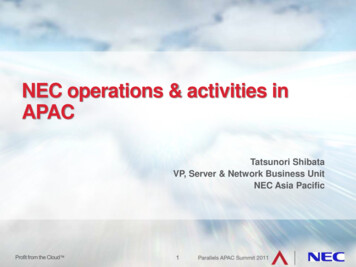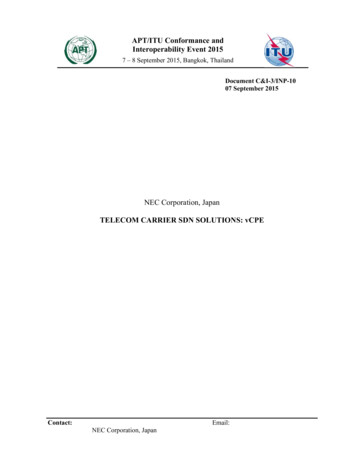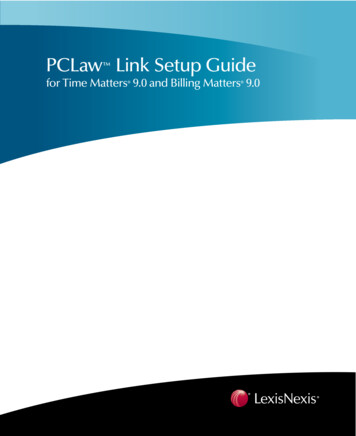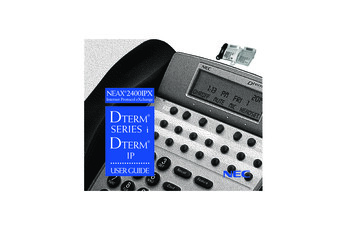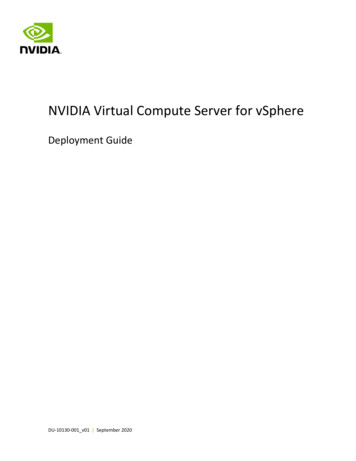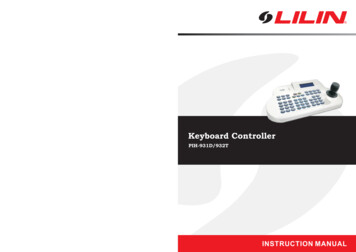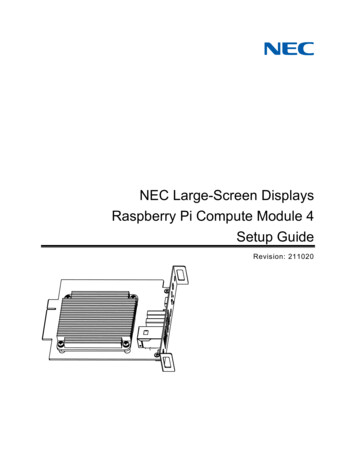
Transcription
NEC Large-Screen DisplaysRaspberry Pi Compute Module 4Setup GuideRevision: 211020
IntroductionThis document describes the features, installation, connectivity, and configuration of the Raspberry PiCompute Module 4 support in NEC Large-Screen display models. Please see “Requirements” on page 10for a current list of supported displays and Raspberry Pi hardware.Notes:1. The acts of disclosure, duplication, and modification of part or whole contents in this referencemanual without permission are prohibited.2. The contents of this reference manual are subject to change without notice.3. Great care has been taken in the preparation of this reference manual; however, should younotice any questionable points, errors or omissions, please contact us.Copyright and TrademarksCopyright 2021 Sharp NEC Display Solutions, Ltd.The content of this manual is furnished for informational use only, is subject to change without notice,and should not be construed as a commitment by Sharp NEC Display Solutions, Ltd. Sharp NECDisplay Solutions, Ltd. assumes no responsibility or liability for any errors or inaccuracies that mayappear in this manual.Windows is a registered trademark of Microsoft Corporation.NEC is a registered trademark of NEC Corporation.Linux is the registered trademark of Linus Torvalds in the U.S. and other countries.Raspberry Pi is a trademark of the Raspberry Pi Foundation.Apple, Macintosh, Mac, macOS and the Mac logo are trademarks of Apple Inc., registered in the U.S.and other countries.Ubuntu is a registered trademark of Canonical Ltd. 2021 Sharp NEC Display Solutions, Ltd.Page 2 of 86
ContentsIntroduction . 2Contents . 3Revision History . 7Basic Features . 8GPIO Summary. 10Interface Board internal connections and jumpers . 10Requirements . 10Important Cautions . 11About Wireless Connectivity (Wi-Fi and Bluetooth) . 11Operating System Programming Procedure . 121Basic Setup and Configuration Steps . 132Installing the Compute Module and NEC Compute Module Interface Board to theDisplay . 143Connections and Internal Operation . 2043.1USB device connections to the Compute Module . 203.2USB connections for programming the Compute Module . 203.3LAN connections . 223.4Software control via IR Remote . 243.5GPIO . 27Preparing and running the tools to program the Compute Module . 284.15Using a Windows PC as a host . 28Miscellaneous Configuration Items. 335.1Enabling the onboard USB 2.0 controller . 335.2Enabling 4K@60Hz video output . 335.3Configuring the correct HDMI video level encoding and decoding . 335.4To disable overscan (if black bars are visible on the sides of the screen) . 355.5To rotate the screen image to portrait orientation . 355.6To enable support for the IR Remote receiver using “lirc” . 365.7To test support for the IR Receiver by outputting raw data . 375.8To enable the serial port (UART) to the display and allowing application access . 375.9Testing internal serial communications to the display using the Python based NEC PD SDK . 38 2021 Sharp NEC Display Solutions, Ltd.Page 3 of 86
675.10Configuring the Compute Module to shutdown using shutdown signal from the display . 385.11Reading and setting the display’s internal Real Time Clock (RTC) from the OS . 395.12Using the display’s Watchdog Timer (WDT) . 405.13Controlling the Compute Module power . 415.14Controlling the cooling fan automatically based on the CPU temperature. 415.15Checking and updating the display firmware version. 425.15.1Update using the NEC Display Firmware Update Tool for Windows . 425.15.2Update display firmware using a USB storage device . 43Related OSD Settings . 446.1Slot Compute Module Power Control Power Supply . 446.2Slot Compute Module Power Control Power Button . 446.3Slot Compute Module Power Control Reset . 456.4Slot Compute Module Power Setting Auto Power Up . 456.5Slot Compute Module Power Setting Auto Shutdown . 456.6Slot Compute Module Power Setting Power Supply Off Delay . 466.7Slot Compute Module Power Setting Auto Display Off . 466.8Slot Compute Module Power Setting Off Warning . 476.9Slot Compute Module Advanced Setting Shutdown Signal. 476.10Slot Compute Module Advanced Setting IR Signal . 486.11Slot Compute Module Advanced Setting Monitor Control . 486.12Slot Compute Module Advanced Setting WDT. 486.13Slot Compute Module Advanced Setting WDT Start Up Time . 496.14Slot Compute Module Advanced Setting WDT Period Time . 496.15Slot Slot Power . 506.16Input Advanced CEC CEC . 506.17Input Advanced CEC Search Device . 516.18Control USB PC Source . 51Useful Information and Commands . 547.1To find out the IP address of the Compute Module from a terminal window . 547.2To restart from a terminal window. 547.3To shutdown from a terminal window . 547.4To run the Raspberry Pi Config utility from a terminal window . 54 2021 Sharp NEC Display Solutions, Ltd.Page 4 of 86
7.5To change the keyboard layout to US from a terminal window . 547.6To add and remove packages from Raspberry Pi OS . 557.7To update the Raspberry Pi. 557.8To install the Python serial module . 557.9To mount a USB flash drive from the terminal . 557.10To access an SMB (Windows share) drive from the Raspberry Pi OS desktop . 567.11To list connected USB devices . 567.12To show available disk space . 567.13To show internal information about the Raspberry Pi . 567.14To download a file to the current directory. 567.15To find a file by name. 577.16To edit a protected system configuration file from the Raspberry Pi OS desktop . 577.17To prevent the screen saver from blanking the screen after several minutes . 577.18Monitoring the system processes, CPU usage, and memory . 577.19To enable and disable video output from the Compute Module to the display . 577.20To create an image of the Compute Module to backup or clone . 587.21Debug GPIO lines and overlay assignments . 587.22Assign different MAC address to the network interfaces . 588Troubleshooting . 599Video CODECs . 6410 Python Based NEC PD SDK . 6511 Compute Module Configuration Tool for Raspberry Pi OS . 6712 Wireless connectivity installation and configuration . 6912.1Important cautions . 6912.2Parts identification . 7012.3Installing the antenna connector to the Compute Module and routing the coax cable . 7112.4Enabling and disabling Wi-Fi at the hardware level. 7612.5Selecting the external antenna in software . 7612.6Bluetooth functionality . 7612.7Troubleshooting wireless functionality. 7613 External reference information . 7814 Frequently Asked Questions . 80 2021 Sharp NEC Display Solutions, Ltd.Page 5 of 86
15 Known Issues . 8416 Support . 8517 Disclaimer . 86 2021 Sharp NEC Display Solutions, Ltd.Page 6 of 86
Revision HistoryRevisionDateModified byDescription210526May 26, 2021Will HollingworthInitial release211020October 20 2021Will HollingworthAdd wireless information 2021 Sharp NEC Display Solutions, Ltd.Page 7 of 86
Basic Features Operating System supporto Select from many publicly available OS distributions and images depending on theapplication, such as: fully featured and ready to use networked media players, kioskinterfaces, full desktop based operating systems, and minimal systems.A custom developed NEC Media Player image is also available.Network connectivityo Gigabit LAN connection on the Raspberry Pi Compute Module Interface Board for directhigh-speed connection to the Compute Module.o 10/100 LAN switch internal to the display provides network connectivity to both thedisplay and Raspberry Pi Compute Module using a single network connection. Thedisplay’s LAN control interface and the Compute Module will have their own IP addressand network settings.o (Multiple LAN port display models 1) Two of the display’s LAN switch ports are availableexternally for daisy-chaining other devices.- LAN1 port should be used to connect to the network.- LAN2 output can be used to connect other LAN devices or displays.o Built-in Wi-Fi on supported models.USB connectivityo Two USB 2.0 Type-A connectors (500mA power) on the Raspberry Pi Compute ModuleInterface Board for connecting devices such as keyboards, mice, and other USBperipherals.o (Display models with “USB-A” connection 2) An additional USB 2.0 internal connection tothe display’s built-in USB Type-A port. This port can be switched between the RaspberryPi Compute Module, another SDM based device, or an external PC. This can be set toswitch automatically, depending on the currently selected video input, or fixed to aspecific source.o Direct programming of the Compute Module from an external PC via a USB 2.0 Micro-Bconnector on the Raspberry Pi Compute Module Interface Board.Internal IR Remote receiver and pass through to the Raspberry Pi Compute Moduleo The display's IR Remote can be used to operate software running on the Raspberry PiCompute Module, such as a media player, via standard IR Remote Control units. The IRRemote communicates to the Compute Module via the display's internal remote controlsensor or external KT-RC3 sensor. It will be necessary to configure such software withthe IR codes for the remote control units being used.o This uses GPIO 18 on the Raspberry Pi.Current display models with multiple LAN ports on the terminal panel: MA431, MA491, MA551, P435, P495, P555Current display models with port labeled “USB-A” on the terminal panel: MA431, MA491, MA551, P435, P495,P55512 2021 Sharp NEC Display Solutions, Ltd.Page 8 of 86
CEC support between the display and the Raspberry Pi Compute Module.o Facilitates the use of the display’s IR Remote buttons to control the basic navigationfunctions of compatible software, such as media players.Internal serial connection between the display and the Raspberry Pi Compute Moduleo Allows full control and monitoring of the display from the Compute Module.o This uses GPIO 14 & 15 (UART0) on the Raspberry Pi Compute Module.o A Python based SDK is available from Sharp NEC Display Solutions for easy softwaredevelopment. See Python Based NEC PD SDK on page 65.Real Time Clock support via the display’s internal clocko The display’s internal Real Time Clock can be read and set via the Compute Module,using the internal serial connection and the Python based SDK.o This can be used to set the system time when no network connection is available.Shutdown signal supporto The display can signal to the Operating System, running on the Raspberry Pi ComputeModule, that the power is about to turn off so the software and OS can shutdowngracefully.o This uses GPIO 23 on the Raspberry Pi Compute Module.Full power controlo Power for the Compute Module can be configured to automatically turn on when thedisplay is turned on from a standby mode, or it can be turned on separately via thedisplay’s OSD, HTTP interface, or network commands.o By default, the Compute Module will remain powered on even when the display goesinto standby mode and can be turned off separately via the display’s OSD, HTTPinterface, or network commands.The display can be configured to turn off the Compute Module power with the displaypower.Watchdog timer supporto Can be used to reset a locked CPU by automatically restarting the Compute Module. Arestart will occur if no periodic reset signal is received from the Compute Module withina certain time period.Built in touchscreen supporto For display models integrated with an optional 3rd party touchscreen, the USB touchdevice will appear as a standard USB HID (Human Interface Device) device to theCompute Module.Wi-Fi and Bluetooth supporto See the following section About Wireless Connectivity (Wi-Fi and Bluetooth) on page 11for information about the wireless connectivity.Coolingo The large heatsink combined with cooling fans integrated within the display simplifiesheat management. 2021 Sharp NEC Display Solutions, Ltd.Page 9 of 86
A temperature sensor within the display automatically starts the cooling fans whenneeded. Additionally, the Compute Module itself can request the cooling fans run bydriving GPIO 24 to a high state. This is compatible with the Raspberry Pi OS Fan GPIOcontrol mechanism.Status indicatoro LED indicator on the Raspberry Pi Compute Module Interface Board shows the status ofpower (red) and activity (orange).o GPIO Summary GPIO 14 & 15 (UART0 TX & RX) – internal serial connection to the display for controlGPIO 18 – (input to Compute Module) demodulated IR receiver from the displayGPIO 23 – (input to Compute Module) shutdown signalGPIO 24 – (output from the Compute Module) cooling fan controlSee section 3.5 GPIO on page 27 for more details.Interface Board internal connections and jumpers A jumper header labeled EEPEOM nWP on the Interface Board can be used to write-protect theCompute Module’s EEPROM by installing a jumper across the two pins.(DS1-IF21CE interface board only.) A jumper header labeled WF nDisable on the InterfaceBoard can be used to disable the Compute Module’s Wi-Fi function by installing a jumper acrossthe two pins.Requirements Compatible NEC display modelso M431o MA431o ME431o P435o M491o MA491o ME501o P495o M551o MA551o ME551o P555o M651o ME651NEC Compute Module 4 Interface Boardo DS1-IF20CE or DS1-IF21CERaspberry Pi Compute Module 4o Supports all eMMC based variants, including all RAM and wireless configurations. 2021 Sharp NEC Display Solutions, Ltd.Page 10 of 86
Note: “Lite” versions of the Compute Module 4 without onboard eMMC Flash memoryare not supported.Internet connectionLAN hub and standard network cablesStandard USB 2.0 or 3.x cable (USB to USB Micro-B) for programming.Lengths of up to 10 feet or 2.5 M can be used with high quality USB cables.Host PC running either Windows, macOS, or Ubuntu, or a standard Raspberry Pi 1 / 2 / 3 / 4running Raspberry Pi OSUSB keyboard and mouse for connecting to the display (recommended)Operating system .img fileSoftware configuration tools (see following sections)o Important Cautions Always disconnect the display from AC power when inserting or removing the Interface Boardfrom the display.The two sets of connectors on the Compute Module 4 and the Interface Board are very fragileand are rated at about 30 insertions maximum. Therefore, do not mate and un-mate the twounnecessarily.When mating the Compute Module 4 to the Interface Board pay careful attention to theorientation of the Compute Module.The included heatsink should be attached to the Compute Module after testing and before finalinstallation to provide cooling for the Compute Module. The included thermal conductive sheetshould always be used between the heatsink and the Compute Module.Disconnect the programming USB Micro-B cable from the Interface Board when programing iscomplete. Leaving it connected will result in the USB ports and internal 10/100 LAN beinginactive.About Wireless Connectivity (Wi-Fi and Bluetooth) The DS1-IF21CE interface board together with a wireless enabled version of the ComputeModule 4 and external antenna kit can be used for Wi-Fi functionality. At the time of writing,Bluetooth functionality is disabled pending regulatory approvals. See the relevant sections ofthis guide for information on installing and configuring the wireless functions.An external USB wireless adapter “dongle” can be used can be used with either the DS1-IF20CEor DS1-IF21CE Interface Boards to provide wireless functions. 2021 Sharp NEC Display Solutions, Ltd.Page 11 of 86
Operating System Programming ProcedureIf a Compute Module was included with the kit, it may be pre-programmed with the NEC MediaPlayerimage. This can be overwritten as desired.Standard Compute Modules from Raspberry Pi are not programmed with an Operating System by default.The OS can be installed after placing the Compute Module in programming boot mode. This allows theCompute Module to appear as a USB device to another “host” PC or Raspberry Pi. The OperatingSystem is then programmed, or “installed”, from the host to the Compute Module over USB. After the OSis programmed successfully, any necessary configuration options can be made, and the Compute Modulecan be restarted in normal boot mode.The “host” can be a PC running Windows or Linux , or a standard Raspberry Pi 1, 2, 3, or 4 withRaspberry Pi OS. If using a Linux based PC or Raspberry Pi as a host, a small utility will need to bedownloaded and compiled on the host.Important: The Compute Module will typically not display video until it has been programmed with acompatible Operating System. 2021 Sharp NEC Display Solutions, Ltd.Page 12 of 86
1Basic Setup and Configuration StepsThe following list shows the basic steps that will be performed:1. Physically install the Raspberry Pi Compute Module 4 into the NEC Compute Module InterfaceBoard and install into the display. See section 2 on page 14 for details.2. Connect the host PC to the Interface Board in the display via the USB Micro-B connector forprogramming the module. Connect other USB devices, such as a keyboard and mouse, forconfiguration and use. See section 3 on page 20 for details.Note: If the Compute Module is to be programmed with a new OS, follow these steps afterconnecting any USB devices:1. Select and download the OS to install on the Compute Module as well as any other softwaretools. See section 4 on page 28 for details.2. Prepare and run the tools to make the Compute Module appear as a Mass Storage device on thehost system so the OS can be imaged.3. Image the OS from the host system to the Compute Module.4. Configure any boot options by editing the config.txt and cmdline.txt files on the boot partition.See section 5 on page 33 for details.5. Restart the Compute Module.6. Configure other boot and runtime options. See section 7 on page 54 for details.7. Check for any system and firmware updates. See section 7.7 on page 55. 2021 Sharp NEC Display Solutions, Ltd.Page 13 of 86
2Installing the Compute Module and NEC ComputeModule Interface Board to the Display1. Disconnect AC power from the display.2. Install a Compute Module into the connector of the Interface Board. Check that the ComputeModule is oriented correctly before fully inserting it into the connector. Carefully align the tworows of connectors and press together evenly to snap together.Caution: Take static precaution measures when handling the boards.Figure 2-1: Install the Raspberry Pi Compute Module3. Confirm the Compute Module is correctly mated by looking at each corner of the InterfaceBoard. Metal posts should protrude from two corners, diagonal from each other.Figure 2-2: Confirm correct installation by alignment of metal postsNote: to ensure proper orientation for Compute Module installation, the Interface Board hastwo diagonal posts that protrude through two corners of the Compute Module. The oppositetwo corners of the Compute Module rest on two screw hole pillars. It is not necessary to secure 2021 Sharp NEC Display Solutions, Ltd.Page 14 of 86
the Compute Module using screws since the heatsink will be used to hold it in place. However, ifdesired two 2mm or 2.5mm M2 screws [not supplied] can be used.4. Check the distance between the Interface Board and Compute Module; it should be equal on allsides.Figure 2-3: Check all sides of the Compute Module on the Interface Board5. (DS1-IF21CE interface board only.) If installing the antenna for wireless functionality, follow thesteps in Section 12 on page 69, then return to the following steps.6. Peel the liner from one side of the thermal conductive sheet and stick the sheet to theunderside of the heatsink.Important: Carefully align the thermal conductive sheet within the engraved marks beforeadhering the sheet to the heatsink for proper alignment over the Raspberry Pi.Figure 2-4: Place thermal conductive sheet7. Peel the remaining liner from the thermal conductive sheet when you are ready to attach theheatsink to the Compute Module Interface Board.Important: Remove the liner before attaching the heatsink to the Interface Board. 2021 Sharp NEC Display Solutions, Ltd.Page 15 of 86
8. Attach the heatsink using the four M3 screws supplied with the kit.Important: Orientate the heatsink with the slotted hole in the bottom left corner beforeattaching, as shown in the figure. The thermal conductive sheet will press against the top of theCompute Module.Figure 2-5: Attach the heatsink to the Interface Board 2021 Sharp NEC Display Solutions, Ltd.Page 16 of 86
Confirm the heatsink is seated correctly by looking at the screw-hole posts on the InterfaceBoard. The two posts on the outside edge should be inserted and flush to the surface of theheatsink. The heatsink rests on top of the two posts closest to the USB and LAN portsconnection.Check the distance between the Interface Board and the heatsink; it should be equal on all sides,the thermal sheet should press against the Compute Module, and the two screw-hole posts onthe outside edge should be inserted into the heatsink.Figure 2-6: Check all sides of the heatsink 2021 Sharp NEC Display Solutions, Ltd.Page 17 of 86
9. On the side of the display, remove the two screws holding the slot cover in place and thenremove the slot cover.Note: Set the screws aside; they are used in the next step for securing the Compute ModuleInterface Board in the display. Do not discard the slot cover. It helps to limit dust and debris from entering the displayand protect the internal components. Store it in a safe place for future use in case theCompute Module Interface Board is removed from the display later.Figure 2-7: Remove slot cover from the display 2021 Sharp NEC Display Solutions, Ltd.Page 18 of 86
10. Insert the Interface Board into the slot. Make sure to carefully align and fully insert the InterfaceBoard into the slot and then secure it with the two screws removed in the previous step.Figure 2-8: Insert the Interface Board in the display11. Reconnect AC power to the display. 2021 Sharp NEC Display Solutions, Ltd.Page 19 of 86
3Connections and Internal Operation3.1 USB device connections to the Compute ModuleThe two USB Type-A inputs on the side of the Interface Board are for connecting downstream USBdevices, such as a keyboard and mouse, additional storage, external sensors and devices, or a Wi-Fiadapter, to the Compute Module. Both connectors are USB 2.0 and can supply 500mA of current each.On some display models 1 there is an additional USB input on the display itself labeled “USB-A” that canbe switched between the Compute Module, Internal PC (SDM), and an external PC connected to theUSB-B connection on the display. It can be configured via the display’s OSD “PC SOURCE” setting (seesection 6.18 on page 51) to switch automatically depending on the currently selected video input or fixedto a specific source. This allows devices such as a mouse or other input device to be sharedautomatically between different sources.For display models1
Internal serial connection between the display and the Raspberry Pi Compute Module o Allows full control and monitoring of the display from the Compute Module. o This uses GPIO 14 & 15 (UART0) on the Raspberry Pi Compute Module. o A Python based SDK is available from Sharp NEC Display Solutions for easy software development.

